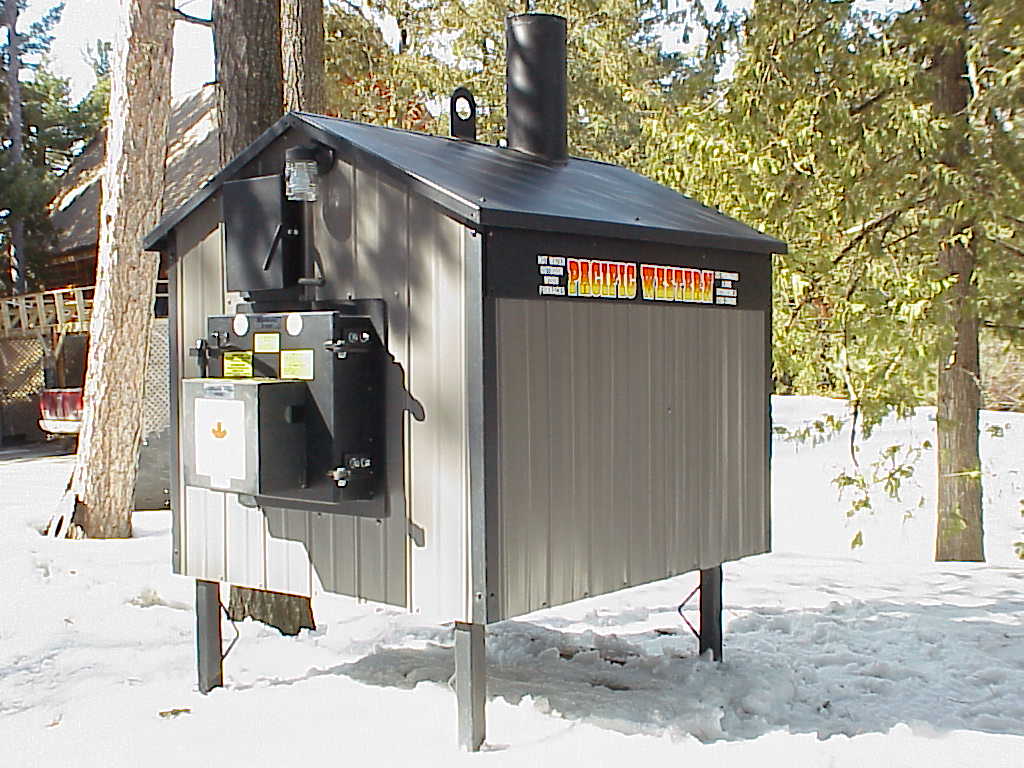|

Large Supply Of Parts In Stock
What is an Outdoor Furnace?
An outdoor furnace is as the name implies - a furnace that sits outdoors.
The furnace, looking much like a small utility building, is a wood-fired, water-jacketed stove.
The water in the jacket is simply heated and pumped underground through insulated pipes to the building that needs to be heated. At this point the heat from the water is extracted.
This process is not expensive and adapts easily to all heating systems. The outdoor furnace concept is very simple, effective, safe and cost-efficient.
As a bonus, it also takes care of all your domestic hot water needs; the element in your hot water heater need never kick in.
We also have models that will fit inside your shop or woodshed.
How Does an Outdoor Furnace Work?
The water temperature at the furnace is maintained by monitor controls at a pre-set temperature range. Hot water is pumped around the clock to the building(s) to be heated. At this point, any of the following methods can be used to extract the heat. The original heating method is not disconnected but now acts as a backup system. The cooled water is returned to the furnace and is re-heated.
Steel Comparison (Our competitors hate this!)
Our traditional round barrel design has been around for over 100 years. These boilers have always been made from mild steel and since there are few seams and no corners or dead spots to trap corrosion, they last!
Most Outdoor Furnace manufacturers "re-invented the wheel" and left the round design. With lots of flat plate, welds and dead spots, the results have been premature corrosion. To combat this corrosion, and rather than change their design, many companies went to stainless steel. Stainless steel may last longer than mild steel in an outdoor furnace, but not all stainless is a "forever" product. There are many grades and some of them are subject to rusting and corrosion. Automobile exhaust systems are made from one of the lower grades; they resist high temperatures but totally corrode. Many manufacturers went to stainless steel to get in on the stainless quality image, but since it's expensive some of them have gone to a low-cost, cheap-grade stainless - which is still subject to rust and corrosion! During the manufacturing and welding process for stainless steel, if the proper quantity and blend of corrosion-resistant and stabilizing elements are used, then it does indeed become a "forever" product. These elements optimize weldability without the need for post-weld annealing to restore ductility, formability, toughness and corrosion resistance.
Why did we go to stainless steel? We went for all the right reasons ... to increase sales and not because we had to change. We've always had a time-tested, corrosion-resistant design (round) that works in mild steel and now we offer you the same design in our Titanium-Columbium-Enhanced Stainless. The best design, the right material and the correct manufacturing process ... we've got it all!
Lifetime 20-year limited replacement warranty.
Cost Comparison
The amount of heat created and used is measured in BTU's. An average home uses 200,000,000 BTU's of total energy for heating per year. This includes 25% usage for the heating of domestic water.
Based on this total consumption of BTU's, the following amounts of fuel would be required to produce 200,000,000 BTU's.
You may have to adjust the price per unit to reflect current local costs.
Heating
Method |
BTU's
Per Unit |
Annual
Requirements |
Total Cost
per Unit |
Annual
Cost |
| Electricity |
3,413/kilowatt hr |
58,000 |
0.10 |
$5,860 |
| Propane |
24,200/litre |
8,264 |
0.25 |
$2,066 |
| Fuel Oil |
36,300/litre |
5,509 |
0.30 |
$1,652 |
| Wood (Birch) |
23,400,000/cord |
8.5 |
50.00 |
$452 |
Benefits of an Outdoor Furnace
Safety. Our furnace is made to be situated in the yard, away from the house. The usual distance is 50 to 150 feet but it can be twice this distance and still do the job. Outdoor furnaces remove the dangers of wood stove fires in the house. Any fire department that compares the safety of indoor units versus outdoor ones will have to admit that outdoor furnaces are the winners; this safety feature is usually reflected in lower insurance rates.
Convenience. The furnace is located out in the yard and can be situated beside the wood pile. This eliminates the mess of sawdust, smoke, ashes, bugs and dirt in the house. Our injection air furnace burns any type and quality of wood, wet or dry, unsplit and in lengths of up to 72". The burn time average can reach 48 hours or more per fill. One furnace can heat multiple buildings; there is no need to purchase a heat source for each.
Cost Savings. Residential and commercial buildings, shops, garages, motels, factories, restaurants can all be heated easily with our furnaces. There is no more need to use gas or electricity to heat domestic water, hot tubs, swimming pools, clothes dryers - our furnaces will do it better and at a fraction of the cost.
Tri-State Installers
496 Willow Springs Rd.
Montfort, WI 53569
Ph/Fax (608) 623-2487
|

